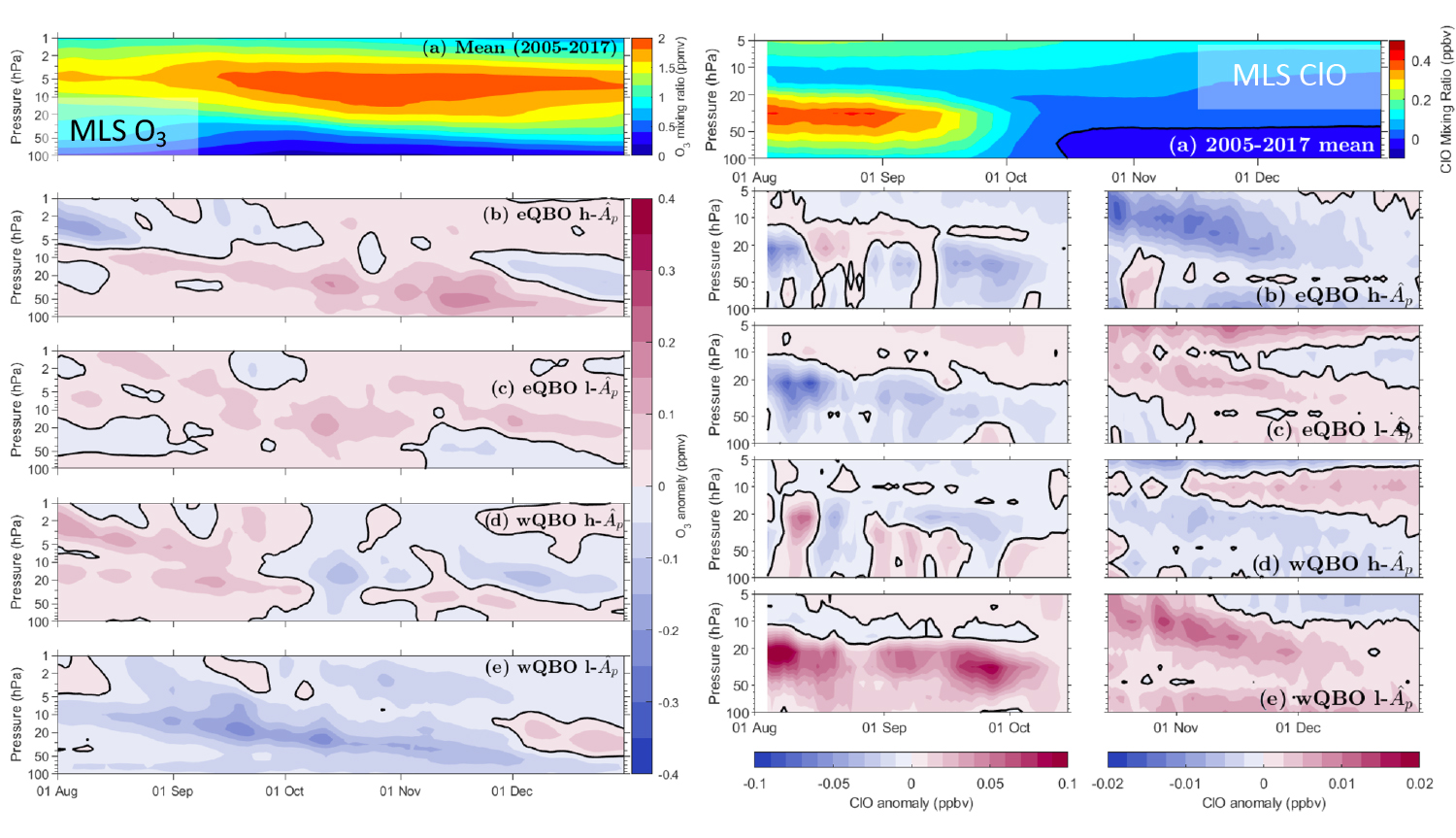The Aura Microwave Limb Sounder (MLS) observes higher springtime ozone in the Antarctic lower stratosphere following winters with above-average EPP, particularly when the QBO (quasi-biennial oscillation) is in the easterly phase (eQBO). MLS ozone anomalies follow the pattern of descent typical of EPP-NOx. Column ozone from the Aura Ozone Monitoring Instrument shows similar correlations with EPP in eQBO. In contrast, MLS observes springtime decreases in reactive chlorine, ClO, following winters with elevated EPP, especially during eQBO. Other satellite data indicate greater abundances of the reservoir species ClONO2 in conjunction with the lower ClO in such years. Thus, in high-EPP years, enhanced NOx shifts chlorine partitioning from ClO to ClONO2, reducing chlorine-driven ozone loss.

Composites of Aura MLS Antarctic ozone (left) and ClO (right) anomalies (deviations from the 2005–2017 mean) show different seasonal evolution in the lower stratosphere for years with high (“h-Ap”) and low (“l-Ap”) EPP activity. The increases in ozone and decreases in ClO seen with enhanced EPP-NOx are more pronounced when the QBO is in the easterly phase (eQBO).
Technical Description of Figure:
(left) Figure 1 of above reference. (a) Aura MLS composite zonal mean polar (60–82S) ozone for 2005–2017 from August through December. Contour interval is 0.2 ppmv. (b) Anomaly from the mean for years with high Ap (geomagnetic activity index used as a proxy for EPP) and easterly QBO (eQBO, determined by the equatorial zonal mean zonal wind at 25 hPa in May). Contour interval is 0.05 ppmv; zero contour in black. (c–e) same as (b) but for different combinations of Ap and QBO phase (easterly or westerly). All data weighted by cos(latitude). (right) Figure 6 of above reference. (a) Aura MLS composite zonal mean polar (60–82S, area-weighted) daytime (SZA < 90 degrees) ClO for 2005–2017 from August through December. Contour interval is 0.05 ppbv. (b–e) Anomaly from the mean for different combinations of Ap and QBO phase. Because ClO abundances change substantially in October, different scales are used for the anomaly from 1 August to 15 October (left panels, contour interval of 0.01 ppbv) and the anomaly from 15 October to the end of December (right panels, contour interval of 0.0025 ppbv); zero contour in black.
Scientific significance, societal relevance, and relationships to future missions:
This paper capitalizes on the long Aura data record to investigate the impact of EPP-NOx variability on lower stratospheric chlorine partitioning and chemical ozone destruction in the Antarctic spring, as well as the extent to which the phase of the QBO affects the contribution of EPP-induced NOx enhancements. NOx plays important roles in stratospheric chemistry, catalytically destroying ozone and also curtailing ozone loss through deactivation of active chlorine (ClO + NO2 --> ClONO2). In a previous paper [Gordon et al., ACP, 2020], the authors found that the correlation between column NO2 and EPP in Antarctic spring was strengthened when the phase of the QBO was taken into account. In addition, they used MLS and other measurements to show that the Antarctic vortex is warmer in eQBO years, inhibiting polar stratospheric cloud activity and thus chlorine activation and ozone loss. In this work, they demonstrate that EPP-NOx exerts additional influence on ozone by shifting the partitioning between ClO and ClONO2. These findings further elucidate the mechanisms by which EPP modulates stratospheric ozone depletion and reinforce the need to account for both EPP and QBO effects in predicting ozone layer recovery. No concrete plans for future measurements of stratospheric ClO (by NASA or other agencies) currently exist.
Data Sources:
References: Gordon, E.M., A. Seppälä, B. Funke, J. Tamminen, and K.A. Walker, Observational evidence of energetic particle precipitation NOx (EPP-NOx) interaction with chlorine curbing Antarctic ozone loss, Atmos. Chem. Phys., 21, doi:10.5194/acp-21-2819-2021, 2021.
04.2021